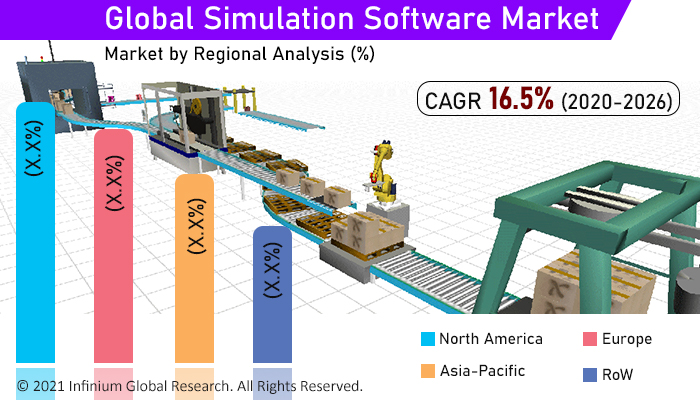Simulation Software Market (Component - Software, and Professional Services; Deployment Mode - On-premises, and Cloud; Application - Product Engineering, Research and Development, and Gamification; Vertical - Automobile, Aerospace and Defense, Electrical and Electronics, Healthcare and Pharmaceuticals, and Others): Global Industry Analysis, Trends, Size, Share and Forecasts to 2026
A recent report published by
Infinium Global Research on the simulation software market provides in-depth
analysis of segments and sub-segments in the global as well as regional
simulation software market. The study also highlights the impact of drivers,
restraints, and macro indicators on the global and regional simulation software
market over the short term as well as long term. The report is a comprehensive
presentation of trends, forecast and dollar values of the global simulation
software market. According to the
report, the global market for simulation the software was sized nearly USD
10 billion in 2020 and is expected to reach up to USD 25 by 2026 growing with a
CAGR of 16.5% over 2020-2026.
Market Insight
Simulations are planned and
performed to duplicate or reconstruct a system or an event to gain knowledge
concerning the associated field. Furthermore, the basic idea of a simulation is
to present and increase the education and training of personals and trainees.
Simulation accommodates to familiarize the trainees with genuine operating
conditions and administration processes. Simulation software is experienced in
the simulation of numerous dynamic procedures. In addition, simulation is used
in numerous fields such as aerospace and defense, healthcare, industrial
manufacturing, and many others. Moreover, simulation software can produce any
model that is dictated by equations or mathematical data and place it in a
pre-defined system. This software helps develop numerous prototypes and test
them virtually.
The global simulation software
market is mainly driven by an upsurge in the adoption of simulation in the
aerospace & defense sector, the haste in demand for the eco-friendly
workplace, and the increase in the practice of simulation software for
healthcare and automotive segments. Particularly, owing to its excellent
feature, it is expansively used in education and the research segment, which
may foster industry growth during the prediction period. Furthermore, creating
real-time simulation situations conserves a lot of money, and it postures less
time to perform, which supports and progresses the core business competencies.
Consequently, this is necessary to have a positive impact on simulation
software market growth. In addition, the simulation software aids accomplish
error-free output in a production procedure, thereby bypassing the production
of faulty products and the respective charges related. However, complexities in
integrating software and increasing data security concerns may hinder the
market growth.
Among the geographies, the North
American region is expected to hold the largest share in the global simulation
software market as countries such as the United States and Canada are the
front-runners of the adoption of innovative technology. Further, the companies
in these countries have been observed to be increasingly investing in research
and development activities in order to introduce technologically advanced
products in the market for simulation software. However, the global simulation
software market in the Asia Pacific region is projected to increase with the
highest rate during the projection period. Increasing AI-based start-ups play
an important role in the growth of the simulation software market in the Asia
Pacific region.

Segment Covered
The report on the global simulation
software market covers segments such as component, deployment mode,
application, and vertical. On the basis of component, the sub-markets include
software, and professional services. On the basis of deployment mode, the
sub-markets include on-premises, and cloud. On the basis of application, the
sub-markets include product engineering, research and development, and
gamification. On the basis of vertical, the sub-markets include automobile,
aerospace and defense, electrical and electronics, healthcare and
pharmaceuticals, and others.
Companies Profiled:
The report provides profiles of
the companies in the market such as Honeywell, Autodesk, Ansys, Siemens AG,
PTC, Dassault Systems, Altair Engineering, MSC Software, Keysight Technologies,
and MathWorks.
Report Highlights:
The report provides deep insights
into the demand forecasts, market trends, and micro and macro indicators. In
addition, this report provides insights into the factors that are driving and
restraining the growth in this market. Moreover, The IGR-Growth Matrix analysis
given in the report brings an insight into the investment areas that existing
or new market players can consider. The report provides insights into the
market using analytical tools such as Porter's five forces analysis and DRO analysis
of simulation software market. Moreover, the study highlights current market
trends and provides forecast from 2020-2026. We also have highlighted future
trends in the market that will affect the demand during the forecast period.
Moreover, the competitive analysis given in each regional market brings an
insight into the market share of the leading players.
